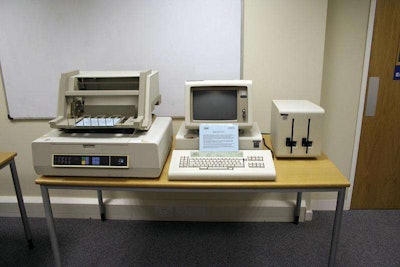John Vosters, chief sales officer, for ITS Compliance, describes how the company is reorganizing its compliance processing centers to deliver a new type of experience for customers.
Jim Matras remembers it like yesterday. While visiting a law office in Madison, Wis., he spotted the earliest version of word processing: the IBM Displaywriter with printer.
The year was 1983. Fascinated, Matras grabbed a ruler and measured the typeface on the printer wheel.
“Oh my God, that’s it!” he thought.
He raced out to buy one and tracked down a company in Hawaii that could modify his print wheels with specialized fonts and symbols to publish tariff guides.
Earlier that year, Matras started a company, Interstate Transportation Services (ITS), and began applying for and defending motor carrier operating authorities and compiling rate tariffs.
Matras, an Interstate Commerce Commision (ICC) practitioner, previously had worked as an administrative law judge for the ICC in Illinois and then for motor carriers to administer their pricing operations.
 The IBM Displaywriter as it appeared in 1983.
The IBM Displaywriter as it appeared in 1983.As a new business owner, he quickly put the IBM technology to use. He created tariff guides that rivaled the quality of the large Washington, D.C.-based publishers who were using custom typewriters and calligraphy.
His electronic processes were more efficient.
“Overnight, we were producing tariffs just like the guys in Washington by punching a few buttons,” he said.
Customers called in regularly to adjust their rates. ITS updated them electronically and then printed and mailed new copies to the ICC and to companies — shippers and other motor carriers — that subscribed to their tariffs.
Business was booming but the ongoing deregulation of the ICC reached a climax in 1987. Applying for motor carrier authority turned into a simple clerical function and carriers no longer needed to publish tariffs.
Revenues fell 80 percent in one month alone.
“We were growing very fast and doing very well,” he says. “And then overnight it was gone.”
Before ICC regulations went away, customers were asking ITS to be a one-stop shop for their compliance needs. As the tariff business dried up, new revenue streams began coming from fuel taxes, logbook auditing, processing vehicle registrations, licenses and permits.
The company became ITS Compliance, a provider of compliance and risk management services for commercial and private fleets.
Creating new services
Matras, the president and CEO, credits a significant amount of growth in the last 6-1/2 years to John Vosters, the chief sales officer, for his work in expanding the client base and the portfolio of services.
 ITS Compliance’s corporate office in Madison, Wis.
ITS Compliance’s corporate office in Madison, Wis.Besides managing hours of service, fuel taxes and driver qualification files for clients, the company also manages drug and alcohol testing, employment background screening, HR record keeping and support, online training and more.
HR services can “go outside the world of transportation,” Vosters says. One client recently asked ITS Compliance to create a custom report to identify which of its drivers had previous job experience that qualified them for non-driving career opportunities. By looking through thousands of imaged job application records, it found what the client was looking for.
Some newer integrated services, like online driver/employee training and real-time reporting of CSA roadside inspection data, come through partnerships with specialized industry suppliers. All services are delivered to clients through a single, integrated ITS point of contact and Web portal.
In March, 2014, ITS Compliance began a new phase of growth by opening its doors to equity investors. With the additional financial resources and support from an equity partner, the company made acquisitions and expanded its workforce, Vosters says, to reach 120 employees and four office locations.
“Without that investment in ITS’ future as a technology organization, we would not be in a position to do the things we are doing today,” he says.
Going electronic
The transportation industry has always consumed copious amounts of paper, especially for compliance, with logbooks, vehicle inspection forms and receipts of all kinds accompanying each load.
 Specialists in ITS Compliance’s office receive data from customers both as scanned images and real-time electronic feeds.
Specialists in ITS Compliance’s office receive data from customers both as scanned images and real-time electronic feeds.Paper is conspicuously absent in ITS’ office, however, because clients scan images of paper documents and upload files through a Web portal. The images are then routed internally to specialists assigned to each customer.
The specialists audit each document for exceptions. They also enter data into proprietary software applications that ITS uses to manage and report the information back to clients.
By visually reviewing each image, specialists can tailor the auditing process to each customer’s needs; and besides, “clients love the flexibility and ability to retain use of their own forms,” Vosters says.
Data also comes electronically, in real time, from GPS locations, hours of service, vehicle inspections and other data captured by onboard computing systems. Exceptions are automatically noted and reported together with the data captured from images.
“We’ve always been able to utilize multiple sources of electronic and paper information from our customers, and match the two up for consolidated final reporting,” explains Vosters. “Our systems are also able to incorporate data received from multiple telematics providers within a single fleet.”
 ITS Compliance can receive real-time data from electronic logging devices.
ITS Compliance can receive real-time data from electronic logging devices.Using real-time electronic telematics data versus paper-based source documents reduces labor costs for ITS Compliance significantly, and it passes these savings onto clients as an additional benefit of investing in telematics. Eventually, Matras believes all information will be arriving electronically.
“The objective for our clients and ITS is to become as paperless as possible in our relationships,” Matras says.
Future endeavors
As ITS Compliance continues to collect more data electronically from customers, the company is expanding the risk management services it offers.
A new version of its customer-facing website, named ITS Comply, will have visual reporting features that enable customers to build their own reports and dashboards to identify risk. The new website will be faster and mobile friendly for all devices, Vosters says.
 ITS plans to release a new version of its client-facing website in January, 2016, named ITS Comply.
ITS plans to release a new version of its client-facing website in January, 2016, named ITS Comply.The company also plans to develop predictive models to identify the most at-risk drivers and new reports that give clients a more granular look at the profitability of their operations.
With a mix of approximately 85 percent private fleet and 15 percent for-hire carriers, Vosters and Matras attribute the company’s success to paying close attention to clients’ needs and being the first to create new services to support those needs. During the past five years, the retention rate of customers has exceeded 98 percent.
“There is nothing here that we are not willing to custom tailor for them,” Matras says.
ITS Compliance uses a monthly subscription model with pricing based on the number of drivers or assets in a fleet. The subscription is fluid every month as clients increase or decrease the number of drivers and assets in their organizations, Vosters explains.
The objective is to provide a tailored service that includes all of the expertise, technologies, services and reporting needed to provide a bulletproof compliance and risk management platform at a 30 to 35 percent reduction from what prospective clients are spending internally, Vosters says.
Across the board, new clients see their compliance levels increase by 30 to 90 percent in the first year of initiating their relationship with ITS, Vosters says. The results are attained by working with customers as an integrated part of their operations and continuously improving how the services and service levels are delivered, similar to how it computerized the tariff business more than 30 years ago.
“We have to figure out ways of being better every day,” Matras says.














